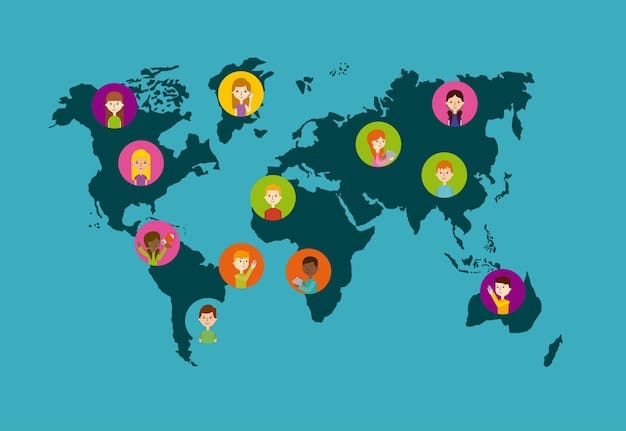International Aid Organizations: A Comprehensive Guide

International aid organizations play a crucial role in addressing global challenges. These organizations provide various forms of assistance, including humanitarian aid, development assistance, and technical support, to alleviate poverty, promote health, and foster sustainable development in the US and around the world.
Navigating the world of international aid organizations can be complex, but understanding their roles and impact is essential for informed engagement and support. From emergency relief to long-term development, these organizations address critical needs both globally and within the US.
Understanding International Aid Organizations
International aid organizations are vital entities that work to alleviate suffering, promote sustainable development, and provide humanitarian assistance on a global scale. These organizations operate across borders, addressing a wide range of issues from poverty and hunger to healthcare and education.
These organizations often collaborate with local communities, governments, and other NGOs to ensure that aid is delivered effectively and sustainably. Their work is crucial in addressing both immediate crises and long-term development challenges.
The Scope of International Aid
International aid encompasses various forms of assistance, each designed to address specific needs. Understanding the different types of aid can help in appreciating the comprehensive nature of these organizations’ efforts.
- Humanitarian Aid: Focuses on providing immediate relief during emergencies such as natural disasters and conflicts.
- Development Assistance: Aims to promote long-term economic and social development in developing countries.
- Technical Assistance: Involves providing expertise and training to support local capacity building and sustainable practices.
By tailoring their approaches to the specific needs of different regions and communities, international aid organizations strive to make a lasting positive impact.
Types of International Aid Organizations
International aid organizations come in various forms, each with its own structure, mission, and focus. Recognizing these different types can provide a clearer understanding of the landscape of international aid.
These organizations can be broadly categorized into governmental, non-governmental, and multilateral entities, each contributing to the overall effort of providing aid and support to those in need.
Governmental Organizations
Governmental organizations, also known as bilateral aid agencies, are funded and operated by national governments. They play a significant role in distributing aid and implementing development projects.
- USAID (United States Agency for International Development): The primary US government agency responsible for administering foreign aid.
- DFID (Department for International Development): The UK government agency focused on international development.
- CIDA (Canadian International Development Agency): The Canadian government agency that provides international assistance.
These agencies often work in close collaboration with recipient governments to align aid efforts with national development priorities.

Non-Governmental Organizations (NGOs)
NGOs are non-profit organizations that operate independently of governments. They often focus on specific issues or regions, working directly with local communities to implement projects and deliver aid.
NGOs are known for their flexibility, innovation, and ability to reach marginalized populations. Their grassroots approach allows them to address needs that may be overlooked by governmental or multilateral agencies.
Examples of Prominent NGOs
Numerous NGOs are active in the field of international aid, each with its own unique mission and approach.
- Doctors Without Borders: Provides medical assistance in conflict zones and countries affected by endemic diseases.
- Oxfam: Works to combat poverty and injustice around the world.
- Save the Children: Focuses on improving the lives of children through education, healthcare, and emergency relief.
These NGOs rely on donations, grants, and volunteer support to carry out their work, often partnering with local organizations to maximize their impact.
The Impact of International Aid in the US
While international aid is often associated with assistance to developing countries, it also has a significant impact within the US. This impact can be seen in various sectors, from disaster relief to community development.
International aid organizations contribute to addressing domestic challenges by providing resources, expertise, and support to local communities and organizations.
Disaster Relief and Emergency Assistance
International aid organizations often respond to natural disasters and other emergencies within the US, providing critical assistance to affected communities.
Following major hurricanes, floods, and wildfires, these organizations mobilize resources and personnel to provide food, shelter, medical care, and other essential services.
- The American Red Cross: Works to prevent and alleviate human suffering in the face of emergencies.
- Salvation Army: Provides disaster relief services, including food, shelter, and counseling.
- Habitat for Humanity: Helps rebuild homes and communities affected by disasters.
Their rapid response and coordinated efforts are crucial in helping communities recover and rebuild after a disaster.
Challenges and Criticisms of International Aid
Despite its positive contributions, international aid is not without its challenges and criticisms. Understanding these issues is important for ensuring that aid is delivered effectively and responsibly.
Common criticisms include concerns about aid dependency, corruption, and the potential for aid to undermine local economies or governance structures.

Addressing the Challenges
Efforts are being made to address these challenges and improve the effectiveness of international aid. This includes promoting greater transparency and accountability, strengthening local capacity, and ensuring that aid is aligned with national development priorities.
By fostering partnerships with local communities, governments, and other stakeholders, international aid organizations can work to mitigate the negative consequences of aid and maximize its positive impact.
- Promoting transparency in aid spending and project implementation.
- Investing in local capacity building to ensure sustainability.
- Aligning aid efforts with national development plans.
Addressing these challenges is essential for ensuring that international aid continues to play a positive role in promoting sustainable development and alleviating suffering around the world.
The Future of International Aid
The landscape of international aid is constantly evolving, driven by changing global challenges and advancements in technology. Looking ahead, several key trends are likely to shape the future of international aid.
These trends include a greater focus on sustainability, innovation, and local ownership, as well as increased collaboration between different types of aid organizations.
Key Trends Shaping the Future
Several key trends are expected to influence the future of international aid, driving innovation and improving its effectiveness.
- Increased use of technology to improve aid delivery and monitoring.
- Greater focus on building local capacity and promoting self-reliance.
- Enhanced collaboration between governmental, non-governmental, and multilateral organizations.
By embracing these trends and adapting to changing global challenges, international aid organizations can continue to make a positive impact on the lives of millions of people around the world.
In conclusion, international aid organizations play a vital role in addressing global challenges and promoting sustainable development. By understanding the different types of aid, the roles of various organizations, and the challenges they face, individuals and communities can engage more effectively in supporting these critical efforts.
| Key Point | Brief Description |
|---|---|
| 🌍 Global Reach | Organizations operate worldwide, addressing diverse challenges. |
| 🤝 Types of Aid | Includes humanitarian, development, and technical assistance. |
| 🏢 NGO Impact | NGOs provide flexible aid directly to local communities. |
| US Aid ❤️ | Offers disaster relief and supports community development. |
Frequently Asked Questions
▼
These are entities dedicated to providing assistance and support to countries and communities in need, addressing issues from poverty to disaster relief.
▼
You can support by donating to reputable organizations, volunteering your time, or raising awareness about global issues.
▼
They offer humanitarian aid during crises, development assistance for long-term growth, and technical support for sustainable practices.
▼
Challenges include ensuring transparency, preventing corruption, and avoiding aid dependency in recipient communities.
▼
NGOs are independent, non-profit entities focusing on specific issues, while governmental agencies are funded and operated by national governments.
Conclusion
In summary, international aid organizations are crucial for global well-being, offering multifaceted support from disaster relief to sustainable development. Understanding their operations, challenges, and impact is essential for informed engagement and effective support in the US and worldwide.





